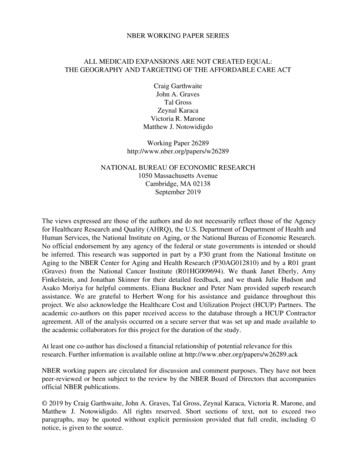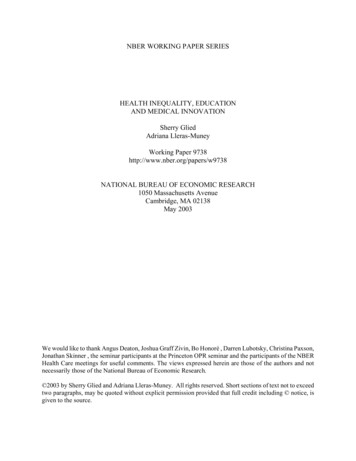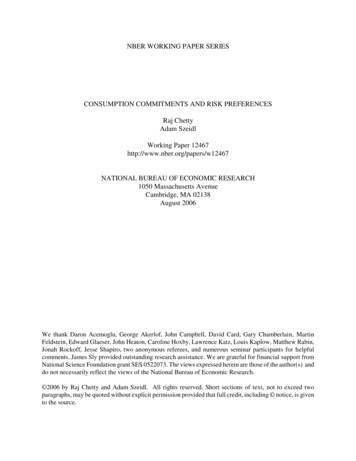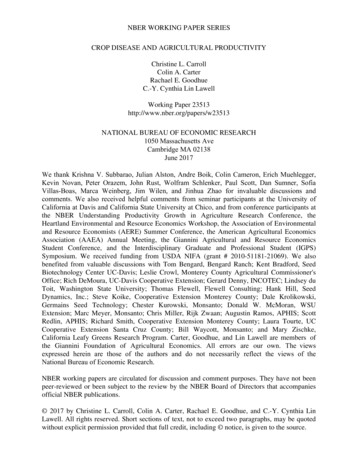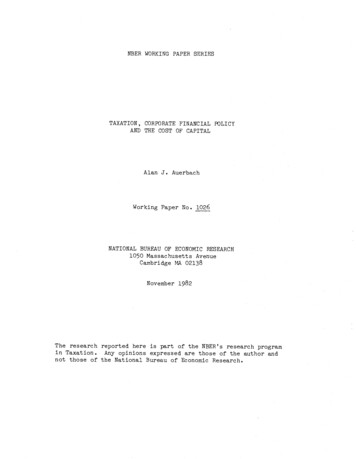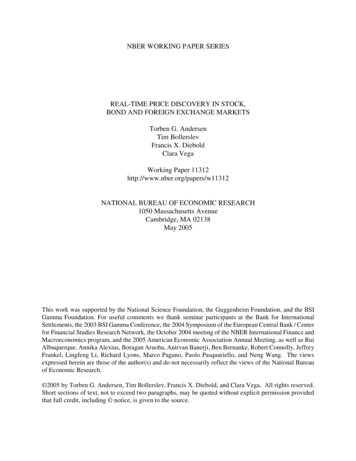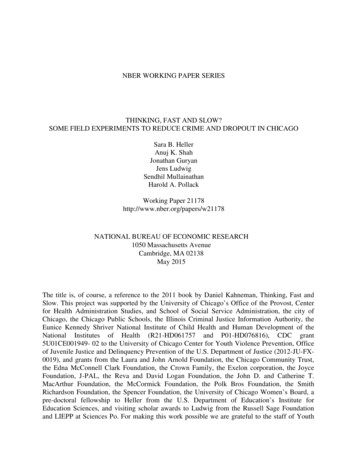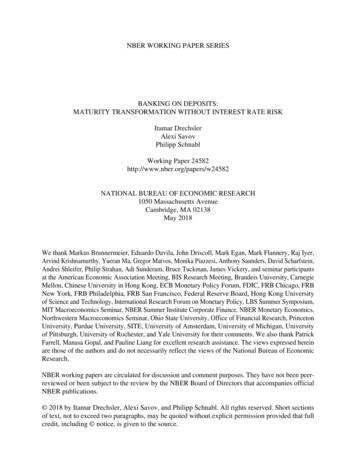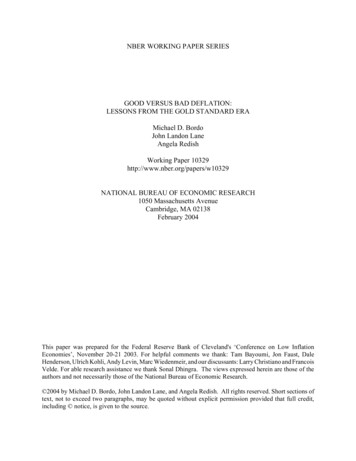
Transcription
NBER WORKING PAPER SERIESGOOD VERSUS BAD DEFLATION:LESSONS FROM THE GOLD STANDARD ERAMichael D. BordoJohn Landon LaneAngela RedishWorking Paper 10329http://www.nber.org/papers/w10329NATIONAL BUREAU OF ECONOMIC RESEARCH1050 Massachusetts AvenueCambridge, MA 02138February 2004This paper was prepared for the Federal Reserve Bank of Cleveland's ‘Conference on Low InflationEconomies’, November 20-21 2003. For helpful comments we thank: Tam Bayoumi, Jon Faust, DaleHenderson, Ulrich Kohli, Andy Levin, Marc Wiedenmeir, and our discussants: Larry Christiano and FrancoisVelde. For able research assistance we thank Sonal Dhingra. The views expressed herein are those of theauthors and not necessarily those of the National Bureau of Economic Research. 2004 by Michael D. Bordo, John Landon Lane, and Angela Redish. All rights reserved. Short sections oftext, not to exceed two paragraphs, may be quoted without explicit permission provided that full credit,including notice, is given to the source.
Good versus Bad Deflation: Lessons from the Gold Standard EraMichael D. Bordo, John Landon Lane, and Angela RedishNBER Working Paper No. 10329February 2004JEL No. E3, N20ABSTRACTDeflation has had a bad rap, largely based on the experience of the 1930's when deflation wassynonymous with depression. Recent experience with declining prices in Japan and China togetherwith the concern over deflation in Europe and the United States has led to renewed attention to thetopic of deflation. In this paper we focus our attention on the deflation experience of the UnitedStates, the United Kingdom, and Germany in the late nineteenth century during a periodcharacterized by low deflation, rapid productivity growth, positive output growth, and where manynations had a credible nominal anchor based on gold: circumstances which have resonance with theworld of today. We identify aggregate supply, aggregate demand, and money supply shocks usinga structural panel vector autoregression. We then use historical decompositions to investigate theimpact that these structural shocks had on output and prices. Our findings are that the deflation ofthe late nineteenth century reflected both positive aggregate supply shocks and negative moneysupply shocks. However, the negative money supply shocks had little effect on output. This we positis because the aggregate supply curve was very steep in the short run during this period. Thiscontrasts greatly with the deflation experience during the Great Depression. Thus our empiricalevidence suggests that deflation in the nineteenth century was primarily good.Michael D. BordoDepartment of EconomicsRutgers UniversityNew Brunswick, NJ 08901and NBERbordo@econ.rutgers.eduJohn S. Landon-LaneDepartment of EconomicsRutgers UniversityNew Brunswick, NJ 08901lane@econ.rutgers.eduAngela RedishDepartment of EconomicsUniversity of British ColumbiaVancouver, B.C.Canada, V6T 1Z1anji@econ.ubc.ca
I. IntroductionRecent concerns by the FOMC at its meeting in May 2003 that the "balance ofrisks in the US had shifted in favor of deflation", similar concerns raised by an IMFReport on Deflation (2003) over the risk of deflation in Europe, especially Germany andSwitzerland, and the experience of declining price levels in China and Japan has sparkednew interest in the subject of deflation. In this paper we examine the issue from anhistorical perspective. We focus on the experience of deflation in the late nineteenthcentury when most of the countries of the world adhered to the classical gold standard.The period 1880-1914 was characterized by two decades of secular deflation followed bytwo decades of secular inflation.The price level experience of the pre-1914 period has considerable resonance forrecent concerns over the possibility of deflation’s re-emergence. Four elements of theearlier experience are relevant for today’s environment: deflation was relatively low (13% in most countries); productivity advance was rapid; the real economy was growing;and the price level was anchored by a credible nominal anchor – adherence to goldconvertibility.Deflation has had a ‘bad rap’. Possibly as a consequence of the combination ofdeflation and depression in the 1930s, deflation is associated with (for some, connotes)depression. In contrast, a basic tenet of monetary theory – the Friedman rule – suggeststhat deflation (albeit perfectly anticipated) is an outcome of optimal monetary policy. Onthe face of it, the evidence from the late 19th century was mixed: on the one hand, themild deflation in the period 1870 - 1896 was accompanied by positive growth in manycountries, however, growth accelerated during the period of inflation after 1896.We distinguish between good and bad deflations. In the former case, falling pricesmay be caused by aggregate supply (possibly driven by technology advances) increasingmore rapidly than aggregate demand. In the latter case, declines in aggregate demandoutpace any expansion in aggregate supply. For example, negative money shocks that are1
non-neutral over a significant period would generate a ‘bad’ deflation. This was theexperience in the Great Depression (1929-33), the recession of 1919-21, and may be thecase in Japan today.1 There is also a third possibility – the Classical case where deflation– for example caused by negative money shocks - is neutral, as when monetary neutralityholds.2We focus on the price level and growth experience of the United States, the U.K.and Germany from 1880-1913. All three countries adhered to the international goldstandard, under which the world price level was determined by the demand and supply ofmonetary gold, and each member followed the rule of maintaining convertibility of itsnational currency into a fixed weight of gold. This meant that the domestic price levelwas largely determined by international (exogenous) forces.We proceed by identifying separate ‘supply’ shocks, money supply shocks and‘non-monetary’ demand shocks using a Blanchard-Quah methodology. We identify theshocks by imposing long run restrictions on the impact of the shocks on output andprices, and then do a historical decomposition to examine the impact of each shock onoutput and the price level.3 We present three sets of empirical results: firstly, results foreach country from estimating a panel over the period 1880-1913, then results fromestimating a panel over only the deflationary period, 1880-96, and finally results from theentire period in a model in which gold supply shocks are included as an exogenousvariable. Contrasting the first two series of results enables us to discuss the symmetrybetween the deflationary and inflationary period, while in the third set we separate moneysupply shocks coming from gold shocks from those coming from intermediation shocks.1The traditional explanation for this non-neutrality is nominal rigidities and more recently balance sheeteffects are also ascribed an important role (Bernanke, 1983).2Many people take issue with the term “good” deflation on the view that any departures from pricestability are problematic. An alternative set of terms that we could use are “benign” versus “malignant”deflation or “the good, the bad and the ugly” as used by Borio and Filardo (2003). These terms connote:productivity driven deflation as used by us; low deflation and stagnation as has been the case in Japan; andthe interwar experience.3A similar methodology is followed in Bordo and Redish (2004). The results of the historicaldecompositions for the money stock, as well as the results from forecast error variance decompositions, arenot presented in this paper for space reasons, but are available from the authors on request. The results areconsistent with those reported in this text.2
The paper begins by briefly describing the data and historical environment. Wethen discuss the empirical methodology to be used. Our empirical analysis is presented inthe next three sections, and the final section discusses the results and their implicationsand limitations.Focussing on our interest in the deflationary episode, our results in a nutshellsuggest that the deflation was generated by monetary factors, but that these monetaryfactors do not explain much of the behaviour of output. Output was determined by nonmonetary factors and the deflation was essentially good or neutral.II. The contextFigure 1 illustrates the behaviour of the money stock, prices (GDP deflators) andreal incomes in the three countries over the period 1880 - 1913. We use broad money(M2) as our measure of money stock, real GDP as our measure of real income and theGDP deflator as our measure of prices.4 While there are differences in the patterns thereare a few common trends: price levels declined – more in the U.S. than elsewhere - overthe period 1880 to the mid 1890s, and subsequently rose. The money stock rose secularly,the most pronounced rise occurring in Germany, and in the U.S. the growth rate increasedafter 1896. Income levels rose with a slight acceleration in the US and UK after the1890s, but German output growth decelerated (very slightly) from its very rapid post1870s rate after the mid-1890s.The period 1880-1913, encompassed myriad economic events. Technologicalchanges occurred rapidly, and earlier changes were implemented at the production level.German and US growth outpaced that of England. Early historians had described theperiod before 1896 as a ‘great depression’ but more recent historiography has recast theperiod as one of deflation without depression (Craig and Fisher, 2000). Although therewere very severe recessions, particularly in the early 1890s, secularly incomes rose.4 Data are available from the authors on request. Sources: US – Balke and Gordon (1986); UK – Mitchell(1998); Germany – Prices: Sommariva and Tullio (1987); GDP: Mitchell (1998); Money: DeutscheBundesbank (1976). Real output is denominated in 1913 pounds sterling while nominal money supply isdenominated in current pounds sterling. The GDP deflators are used as the price series and these are basedin 1913.3
Particularly noteworthy is the transmission of business cycles across economies, with allthree of our economies experiencing common cycles.5At the monetary level there were also secular trends and cyclical fluctuations. Thegold standard tied the quantity of money to the stock of gold. Figure 2 shows that worldgold production was constant and relatively low from 1870 to 1890 while after the early1890s it grew. The growth reflected gold discoveries in South Africa as well as Australiaand North America.III. MethodologyOur empirical analysis is grounded by a model of money supply under the goldstandard. The appropriate modeling strategy depends on the time horizon of interest,whether one is interested in the very long run, the long run or business cycle frequency.The ‘very long run’ we consider to be a period long enough for the quantity of goldmined to respond endogenously to macroeconomic variables.6 Given the short span ofdata available for our empirical analysis, we do not attempt to capture effects over thisperiod, and restrict ourselves to long run and business cycle frequencies.The long run is defined here as a period over which purchasing power parityholds, and we model a world comprising several gold standard economies linked togetherby trade in gold, goods and capital. We assume that in each economy the quantity ofmoney is a stable function of the country’s stock of monetary gold, but the function isallowed to vary across countries reflecting, for example, the existence or not of a centralbank, required reserve ratios, the degree of monetization and the nature of the bankingsystem. The world price level is determined by the world demand for money (based onthe determinants of velocity and aggregate income) and the supply of money (the supplybeing determined by stocks of gold and the nature of intermediation). Individualeconomies take the world price level as exogenous. For each country we identify three5See IMF (2002) and Bergman, Bordo and Jonung (1998).For example, models in Bordo and Ellson (1985) and Dowd and Chappell (1997) allow the quantity ofgold mined to respond endogenously to the price level, through investment in refining technologies andexploration. See also, Barro (1979) and Rockoff (1984). Rockoff argues that the increased gold productionof the late 19th century was a response to the incentive of the high real price of gold (i.e. low price level).64
shocks that drive the joint behaviour of prices, output and the money stock: a moneysupply shock, a technology shock, and a non-monetary demand shock, where thedefinition of each shock is implicit in the identifying assumptions described below.We model output, prices and money supply using the following tri-variate VARin differences:p(1) yt Dtα B j yt j ε t ,j 1where yt ( pricet , GDPt , M t ) and Dt is a matrix of deterministic variables that includesa constant and possibly a time trend. The data are tested for the presence of a unit rootand are differenced to make them stationary.Underlying the reduced form specification, (1), is a set of structural innovations,ut, that are orthogonal to each other and are related to the reduced form innovations in (1)by(2)ε t Cut .Our aim is to identify orthogonal shocks, ut, that can be interpreted as anaggregate supply shock, a nominal money supply shock and a non-monetary aggregatedemand shock. To this end, we identify C by imposing long-run restrictions on thestructural impulse response functions implied by (1). These long-run restrictions areimposed using the method described in Blanchard and Quah (1989).In order to exactly identify C for each country, we need to impose at least threeindependent long-run restrictions on the impulse response functions from (1). Ourpreferred identification is as follows: An aggregate demand shock is assumed to havezero long-run impact on output and prices. That is, the demand shock has no permanentimpact on prices or output. We also assume that the aggregate supply shock, in thecontext of the gold standard, has no permanent impact on prices. That is, the long-runimpact of an aggregate supply shock on price is zero.5
This identifying restriction follows from the fact that the countries in our samplewere all strictly adhering to the gold standard during the sample period. An aggregatesupply shock would be expected to initially lower the price level and increase real output.The decline in the price level would lead in turn to a gold inflow via the current account,hence raising the money supply and price level. Thus, gold flows will have the effect ofcausing price levels, in the absence of further shocks, to return to their original levels.These three long-run restrictions are enough to exactly identify C and henceidentify the structural shocks, ut. We thus impose no restrictions on the impact of thethird shock. This is the only long run influence on the price level and can be interpretedas a world price level shock or, in the context of our model, as a money supply shock.The aggregate demand shocks are presumably an aggregate of money demand shocks andtemporary spending shocks, which cannot be disentangled. The effect of such anaggregate on prices and output in the short run would depend on its component mix, andwe essentially treat this as a reduced form construct.A summary of our preferred identifying restrictions is:1.An aggregate supply shock has no long-run impact on prices.2.An aggregate demand shock (combining the impact of velocity and spendingshocks) has no long-run impact on either prices or output.3.The long run (and short run) impact of a nominal money supply shock on money,output and prices is unrestricted.The long-run impact of shocks to ut, the structural innovation vector, is(3)LR ( I A(1)) 1 C ,where A( L) I A1 L K A p L p and A(1) I pj 1 A j . Assuming that the structuralinnovation vector is ordered as u t (money shock t , supply shock t , demand shock t )′ thenthe long-run impact matrix is6
(4) LR11LR LR21 LR310LR22LR320 0 .LR33 In addition to our preferred identification there are other possible long-runrestrictions that could have been imposed. The most likely additional restriction is moneyneutrality, which would imply that the long-run impact of a money shock on output iszero. The addition of this long-run restriction leads to the long-run impact matrix(5) LR11LR 0 LR310LR22LR320 0 .LR33 Clearly this leads to an over-identified system. Following the method described inAmisano and Giannini (1997), the over-identifying restrictions imposed in (5) can betested. If this extra long-run identification cannot be rejected it will be imposed.However, we prefer not to impose money neutrality but rather allow the data to tell us ifmoney neutrality holds during this sample. Only then do we impose this additional longrun restriction.Another possible combination of the four long-run restrictions given in (4) and (5)would be(6) LR11LR 0 LR31LR12LR22LR320 0 .LR33 In this specification money neutrality would be imposed while the impact of the supplyshock would be unconstrained. The set of constraints given in (6) exactly identify thestructural shocks. If (5) is rejected we are left with a decision on whether to use (4) or (6),and opt for (4) on the basis of the historical context.Given the small sample size inherent in the data there are efficiency gains frompooling the data and estimating a panel VAR (PVAR) given by7
p(7) y it Dt α i Bij y it j ε it ε it N (0, Σ i ) .j 1The maintained assumption in this exercise is that the slope coefficient matrices,Bij, are common across the countries in the panel. Different growth rates betweencountries and periods are allowed by permitting the constant terms in each VAR to bedifferent. Also, the variance-covariance matrix of the innovations for each countryspecific VAR, i , is allowed to differ across countries. This assumption allows for crosssectional heteroscedasticity in the data. One implication of permitting cross-sectionalheteroscedasticity is that individual countries are not constrained to have the sameresponses to structural shocks. All that is being assumed is that all countries have thesame slope coefficient matrices in the reduced form VAR. Also, the values of the slopecoefficients do not change throughout the sample. These two assumptions are tested andthe results of these tests are reported in Table 1 and Table 2.The PVAR in (7) is estimated using the standard seemingly unrelated regressionestimator (SURE) with cross-equation restrictions imposed as defined above. This allowsus to exploit the panel structure and any contemporaneous correlation in shocks betweencountries to improve the efficiency of our estimates. After estimating our PVAR we thenestimate Ci for each country using the scoring algorithm defined in Amisano andGiannini (1997) and use these estimates to calculate structural impulse response functionsfor each country. Once we have Ci we are also able to construct the structural shocksimplied by (2).The structural impulse response functions isolate the impact of each of ouridentified shocks on each variable. Since we impose no restrictions on the impact effectsof the shocks, we can use consistency between the theoretical predictions for the impacteffects and the estimated impulse response functions to make the case that our economicinterpretation of the estimated shock is valid. Having made that case, the historicaldecompositions allow us to do the counterfactual analysis that is inherent in ourquestions: How would output and prices have evolved if there had been no monetary8
shocks? What were the relative contributions of money and real shocks to the late 19thcentury deflation? These results are reported in the next Sections.IV. Results – Full SamplePrior to estimation we analyzed the time series properties of the data andconcluded that all the series were I(1) and we therefore estimated the model in firstdifferences. That is, we estimated (7). Information criteria tests suggested that a modelwith two lags fit the data well (that is p 2), and we included a trend break in all series in1896. Given that the series are all non-stationary and that we estimated (7), the break intrend is handled by putting a dummy variable that takes the value of 0 before 1897 andtakes the value of 1 from 1897 until 1913. Clearly using two lags in (7) would haveseverely affected the degrees of freedom of the estimator for the individual estimation.Table 1 reports tests of slope parameter equality across the countries in the sample. Thatis, Table 1 reports Wald test results for the test given in (8):H 0 : Bij Bkj i, k for each j(8)vs.H A : Bij Bkj for some i, k and for some j.This test was performed using data from the whole sample (1880-1913) and usingdata for the deflationary sample (1880-1896). In both cases the null hypothesis could notbe rejected so that our assumption of similar short-run dynamics across the countries inour panel is not rejected by the data. Given that there appears to be a trend break in 1896a test was performed to see if there was also a structural break in the short-run dynamicsof the VAR. That is, we tested to see if the estimates of Bij were significantly different forthe two different periods. Results from these tests are reported in Table 2. For eachcountry individually and for the panel estimate there is no evidence of a structural breakin the short-run dynamics of the system. Therefore, we account for the break in trendwith intercept adjustments only.Structural impulse response functions were estimated using identifications (4) and(5). The over-identifying restrictions in (5) were tested and these results can be found in9
Table 3. Estimating (1) using data from each country individually we see that the overidentifying restrictions are rejected for each country. When we estimate (7) using thepanel estimator we see that neutrality is rejected for the US and the UK but not forGermany. Therefore we do not impose neutrality and so use identification (4) to computethe structural impulse response functions.Structural impulse response functions showing the impact of a 1% shock arereported in Figures 3 through 5. Standard error bands show 90% approximate asymptoticconfidence intervals calculated using the method described in Amisano and Giannini(1997).7 We observe for all countries that the money supply shock has a large positiveimpact on output in the short run, and a much smaller (zero for Germany) long runpositive impact. In the US, prices and the money stock rise proportionately in response tothe money shock, though in the other countries the price effect is larger. In each case thesupply shock is observed to cause a significant temporary decline in prices (recall that thelong run impact is imposed to be zero). In the US, the long run income elasticity ofmoney is roughly unitary (that is, the money stock increases proportionately withincreases in income) while in Germany and the UK it is somewhat less that unitary.Consistently with the interpretation as a demand shock, the direction of the impact of thethird shock is the same for prices and output. In each case the shock has a negative shortrun impact on prices and output, and a positive impact on money stocks, which isconsistent with an interpretation that velocity shocks dominated the demand influences.Historical decompositions for each shock are reported in Figures 6 through 8.The three panels each contain plots of three series: the actual path of the variable, abaseline – which incorporates trends and shocks before the estimated period but none ofthe shocks during the estimated period; and a line showing the baseline plus the effect ofone of the structural shocks. If the third line lies essentially on top of the baseline, thenthe isolated shock had no effect on the variable, while if the third line lies on top of theactual line, it shows that the isolated shock accounts for the behaviour of the variable.7In fact probably less than 90% given our small sample size.10
In all three countries the behaviour of the price level is driven by the moneyshock. That is, while the impulse response functions show that supply shocks have shortrun price effects, the quantitative impact of those effects is negligible. More germane toour interests is the behaviour of output. In the UK and Germany supply shocks explainvirtually all output fluctuations. In the United States, supply shocks are the dominantdriving force, however, in a number of years money supply shocks have a noticeableimpact. This is consistent with the conventional wisdom that US monetary institutionsexacerbated output volatility in these periods. In all countries the impact of the demandshocks was small.The estimated structural shocks are shown in Figure 9. Consistently with ourinterpretation of the history of the period, the money supply shocks are correlated acrossthe three countries, as are the supply shocks. The demand shocks are uncorrelated,suggesting that there was a significant idiosyncratic component to the temporary shocks.Two sensitivity analyses were carried out to check the robustness of our results.First we replaced M2 with M0, the monetary base, as our measure of money stock.Second we included dummy variables for 1907 and 1908, a period of financial crisis forthe countries in our sample, in the VAR. In both cases, while the magnitudes of theimpulse response functions were slightly different, the qualitative results described aboveremain. This was the case for the benchmark VAR for the entire period and thesubsequent VAR where we add in the world gold stock as an exogenous variable.V. Deflationary Period ResultsUsing the panel consisting of the three core countries, a PVAR is estimated usingdata from the period 1880-1896. This period saw a substantial price deflation as seen inFigure 1. Taking into account the first three periods that are lost due to first differencingthe data and the two lags used in the PVAR, there are 14 observations for each country.Clearly, this would not be enough data to estimate the VAR for each individual countryin the sample. However, in the PVAR data are pooled from the three countries in thepanel so that we have a total of 42 observations at our disposal. The test statistic of the11
test of slope coefficient equality across countries is 35.75 with a p-value of 0.481 (seeTable 1). This means that there is no statistical evidence to suggest that we cannot poolthe data for the deflationary period.We began by testing for the over-identifying restrictions in (5), and the results arereported in Table 3. Similar to the full sample case we see that the test is rejected for theUS and is not rejected for Germany. However, for the UK the p-value is now 0.08. Usingthe full sample in the PVAR the p-value for the UK was smaller than 0.001. Given thatthe point estimate of the long run impact of money on output is similar, at about 0.5%,the change in the p-value is most likely due to the smaller sample size, and hence largerstandard errors, rather than there being anything different for the UK in the deflationaryperiod. We therefore proceeded by estimating the model without monetary neutrality(that is, the model of equation (4)). Figures 10-12 report the structural impulse responsefunctions for each country.Overall, the impulse response functions for the deflationary period have the samequalitative appearance as in the full sample. In particular, for the US and UK the impulseresponses show that a money supply shock which has a given effect on the long runmoney stock has the same estimated impact on output in both the full sample and thedeflationary sample. This is an implicit test of the symmetry of the responses in thedeflationary period and inflationary period, and suggests that, for the late nineteenth/earlytwentieth period that we are examining, responses were symmetric in the two eras.Finally the results of the historical decompositions of output are shown in Figures13-15. While the sample sizes for the individual countries are small, it is clear for eachcountry that the behaviour of prices was driven by the money shock. That is, the deflationof the late nineteenth century was generated by negative monetary shocks. The behaviourof output is again largely driven by supply shocks, although in the mid-1880s US outputreflected the impact of all three types of shocks.12
VI. Results for the full period with exogenous gold shocksOur preferred identification, (5), is driven by the fact that during the period of oursample, the countries in our panel were all on the gold standard. We are thereforeinterested in knowing what role, if any, gold shocks played during this period. The modelthat is estimated is(9)pmj 1k 0 y it α i 0 α i1 D1896t B j y it j γ k Gold t k ε it ,where Goldt is the total world gold stock.8 In this specification gold is completelyexogenous to the system. As noted in Section 3, at very long horizons the world goldstock may be endogenous, but given the time span of our data exogeneity is a reasonableassumption. Table 4 shows the results of a Hausman type test for exogeneity. For allcountries and all variables we cannot reject the hypothesis that gold is exogenous to ourvariables.9 A panel VAR is estimated using (9) with slope coefficients, Bj, and the impactcoefficients of gold, γj constrained to be equal across countries. Table 1 contains theresults of the Wald test that tests whether the coefficients on gold in (9) are commonacross the countries in the panel. The reported p-value for this test is 0.63 so thehypothesis that the gold coefficients are common across countries cannot be rejected.Figures 16 to 18 depict the structural impulse response functions calculated usingthe estimates of (9). These figures are qualitatively similar to t
Good versus Bad Deflation: Lessons from the Gold Standard Era Michael D. Bordo, John Landon Lane, and Angela Redish NBER Working Paper No. 10329 February 2004 . The appropriate modeling strategy depends on the time horizon of interest, whether one is interested in the very long run, the long run or business cycle frequency. .
